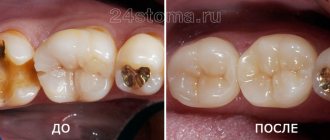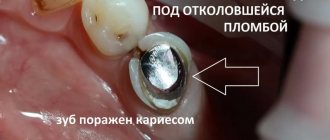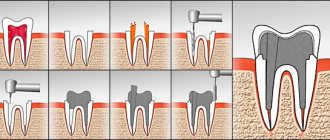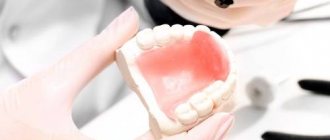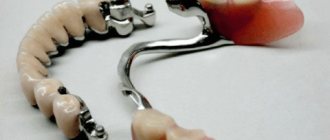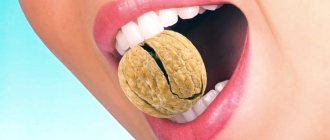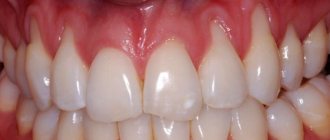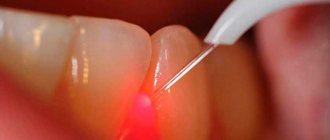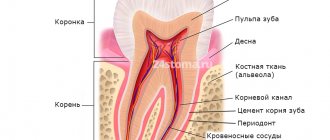Dental pin: what is it, its advantages and disadvantages
What is a dental post? This is a specialized dental structure that looks like a rod. It is installed into the tooth root as a support for a filling or crown. Installation of a pin is only possible if the tooth has a healthy root. As a rule, this design is used if the tooth is badly damaged and thin walls remain.
Advantages:
- reducing the load on the tooth root;
- the ability to restore the crown in just one visit to the dentist;
- ease of installation;
- high level of aesthetics of the future artificial tooth;
- relatively low cost.
Flaws:
- instability under heavy chewing loads;
- there is a risk of damage to the root walls;
- allergic reactions and the development of secondary caries are possible;
- metal rods can only be removed together with the tooth.
To successfully install the pin, the following conditions will need to be met:
- the length of the rod must be at least 2/3 of the length of the dental canal;
- the size of the rim of healthy tooth tissue is at least 2 mm;
- root canal treatment was carried out with high quality;
- the root canal was given a cylindrical or conical shape.
Main stages of prosthetics
Prosthetics by installing a pin and a crown on a tooth includes the following steps:
- preparation: examination, x-ray diagnostics, which reveals hidden pathologies, sanitation of the oral cavity,
- selection and installation of a pin (one or several, depending on the number of roots),
- installing a small seal on top,
- taking casts (impressions),
- production of an artificial crown in a dental laboratory,
- fitting and permanent fixation of the prosthesis.
Prosthetics take from 1 week to 1-2 months, because the patient may have a complex pathology that will require long-term treatment (for example, gingivitis, chronic pulpitis). Or the clinic will not have its own laboratory, then the crown will have to be ordered from a third-party company.
REPROSTHETICS WITH ACRYLIC PROSTHETICS - RUB 200,000.
Re-prosthetics with an acrylic bridge on a metal frame (all included) up to 12 units.
Save RUR 30,000. Call now or request a call
How long does it take to install a pin and how painful is this process?
The duration of the procedure directly depends on the initial condition of the oral cavity. If there are no problems, the pin is placed in one visit to the dentist. If periodontal diseases and other pathologies are present, a pin will be installed in the tooth root only after they have been eliminated.
Since the doctor touches soft tissue during the implantation of the supporting element, the procedure is often accompanied by painful sensations. The occurrence of pain after nerve removal is a natural process. But if a long-depulped tooth hurts, it is possible that the rod has entered too deeply into the canal. X-rays will help identify the cause of the pain.
Dentists on Rimskaya
Gneusheva Elena Viktorovna
Dentist-orthodontist, pediatric orthodontist
Experience: 20 years
★ For more than 13 years she worked at the Moscow State Medical University at the Department of Orthodontics and Children's Prosthetics, Ph.D.
Gorokhova Inga Vitalievna
Dentist-therapist
Experience: 14 years of total experience
★ Expertise in restorative dentistry to make your teeth shine
Konstantinov Oleg Nikolaevich
Dental surgeon
Experience: 25 years
★ Virtuoso of painless treatment. Patients fall asleep in the doctor's chair
Nikolaychuk Anna Vladimirovna
Chief physician, dentist-therapist
Experience: 20 years
★ Chief specialist in the treatment of toothache. Masterfully deals with problems quickly and permanently
Frolova Alexandra Ivanovna
Dentist-therapist
Experience: 25 years
★ A brilliant specialist with many years of experience as a manager in public dentistry
Indications and contraindications for installing pins
Indications:
- damage to the tooth crown by more than 50%;
- the need to create support for prostheses;
- tooth loss;
- weakening of the tooth due to dental diseases.
Contraindications:
- untreated caries;
- the presence of inflammatory processes in the area of the tooth root;
- root destruction;
- blood diseases;
- insufficient thickness of the root canal;
- the presence of caries and periodontal inflammation;
- granulomas, cysts;
- exacerbation of systemic diseases;
- pregnancy;
- allergy.
It is important to know. The choice of the most suitable type of pin is always up to the doctor. It is unacceptable to focus only on the cost of the dental structure.
Situations in which it is necessary to remove an installed crown
Unfortunately, there may be circumstances in which an existing crown may need to be removed:
- An active inflammatory process under the prosthesis, most often resulting from poor-quality endodontic treatment. To eliminate inflammation, the prosthesis is removed, the tooth canals are re-treated, after which the prosthesis is reinstalled;
- The crown is inconvenient for everyday use and causes serious discomfort to the patient. The reason for this phenomenon is always errors made during the production process of the crown.
Crowns are also removed for repairs and planned replacement, if complications arise after the restoration.
In order for the crown installation process to be successful, and for the structure to serve you flawlessly for many years, while maintaining functional and aesthetic characteristics, the prosthetic procedure should be carried out in a modern dental clinic, with an experienced and competent specialist.
Our Unident clinic in St. Petersburg is equipped with high-tech equipment that allows us to perform dental prosthetics quickly, efficiently and with long-lasting results. In their work, the clinic’s specialists actively use innovative technologies and materials from the world’s best manufacturers, and therefore by contacting us you can have no doubt about the quality and safety of treatment!
Branches of our clinic are located at the metro stations: Akademicheskaya, Vyborgskaya and Pionerskaya and you can choose the branch that will be most convenient for you to get to. Make an appointment with us by phone or through the interactive form on the website and come to Unident for a beautiful smile and healthy teeth!
Pin Installation Procedure
How to install a pin in a tooth? The procedure occurs in several stages:
- Removal of all dental tissues affected by caries.
- Preparing the bed for the pin using a special reamer and calibration cutter.
- Root canal preparation.
- Fitting the rod to the tooth.
- Installation of the pin; dual-curing adhesive is used as a fixing element.
- Restoration work using a crown or prepared filling material.
The Saint-Dent Clinic in Moscow offers a wide range of dental services for adults and children. The current cost of services can be found here, the contact page is located here.
Content
- Details about the pin
- Details about the tab
- Materials for production
- What the inlay and pin have in common
- Differences
- What to choose - pin or tab
Currently, dentists offer many options for prosthetics and dental treatment. Modern technologies can solve almost any problem. It is important to choose the best option for a particular case. If treatment of a decayed tooth is required, the choice is between an inlay and a pin.
PROMOTION
Dental restoration, installation of fillings
from 2200 rub.
Possible complications
- severe pain, swelling;
- root fracture;
- restoration chips;
- the occurrence of a local allergic reaction to the material from which the rod is made;
- development of the inflammatory process (stomatitis, periodontitis);
- cyst development;
- fistula formation;
- mechanical damage to the walls of the tooth, which can lead to perforation of the root canals;
- splinters from dental instruments getting into the root canal.
It is important to know. The most dangerous complication is rejection of the installed supporting element by the body. In this case, it must be completely removed from the oral cavity.
Recommendations for the recovery period
To ensure that the recovery period passes as quickly as possible, and getting used to the installed structure is as comfortable as possible, it is important to follow the recommendations of dentists:
- During the period of tissue healing, it is necessary to avoid solid food due to the likelihood of injury;
- On the first day after the procedure, it is forbidden to brush your teeth (after this time, you must maintain careful oral hygiene to avoid infection);
- It is forbidden to use toothpicks throughout the entire recovery period;
- It is necessary to take medications, if prescribed by the attending physician, following the indicated dosage and dosage regimen;
- It is important to attend all preventive appointments prescribed by a specialist - they will assess how the pin is taking root, and the patient can ask all the questions he has.
By following these simple recommendations, the patient contributes to a faster recovery after the intervention, and also reduces the likelihood of complications that may arise due to tissue infection.
The use of the technique of installing pin structures in dentistry has allowed thousands of patients to restore damaged teeth, avoiding their removal and maintaining their original functionality. They can serve the patient for more than 10 years, and their price is quite low compared to standard implantation. The technology is highly effective - complications occur quite rarely, and teeth on a pin are no different in their functions from an ordinary unit of the dentition.
What to do if a tooth with a pin hurts
In the first hours, rinsing the mouth with a soda solution (1 teaspoon of soda per glass of water) will help relieve toothache. A decoction of chamomile and sage has a similar effect. You can also take painkillers and apply ice to your cheek in the area where the pin was placed.
It is important to know. The occurrence of slight swelling and pain in the first days after installation of the pin is normal. But if these symptoms persist for a long time and the patient experiences an elevated body temperature, you should consult a dentist.
Material of manufacture
A variety of materials can be used, including:
- Metals and composites are the most popular option, they are easy to manufacture, durable and have an affordable price;
- Ceramic - similar to natural tooth enamel, the most aesthetic option;
- Zirconium - combines the best qualities of the previous options - they are aesthetically pleasing and durable, but are not very popular because they are very expensive.
The most common questions about pins and answers to them
Is it always possible to get by with a pin?
Unfortunately no. In case of significant tooth decay, when there is a risk of further destruction of the coronal part, dental prosthetics are recommended.
How to care for your teeth after having a pin installed?
For two weeks, it is not advisable to eat too hard food and use toothpicks. When brushing your teeth, you need to be as careful as possible so as not to injure your gums.
Is there an alternative to a dental post?
Yes, you can install a stump tab instead. This is a microprosthesis, the lower part of which is fixed into the root canals, and the upper part serves as a supporting element for an artificial crown.
How to make the right choice
There are certain requirements for material compatibility. So, for example, a crown on a tooth on a metal pin (anchor or regular thickness) should be metal-ceramic. If you place a ceramic crown here, then, firstly, the metal will become visible through the thin translucent ceramics, and secondly, the ceramics may crack due to different strength indicators with the metal.
Fiberglass, ceramic, and zirconium dioxide are suitable for aesthetic ceramic and ceramic-composite crowns. Under the zirconium dioxide prosthesis, you can place a rod made of the same material or metal.
